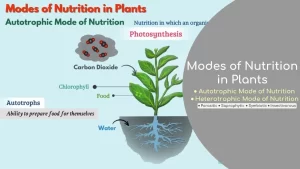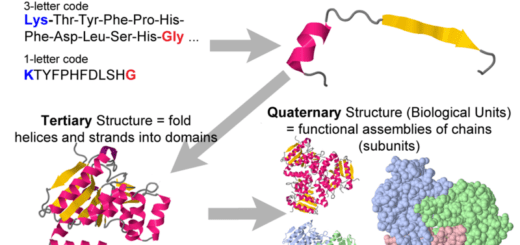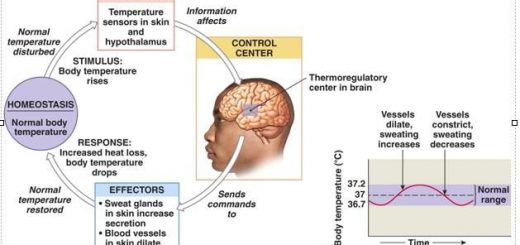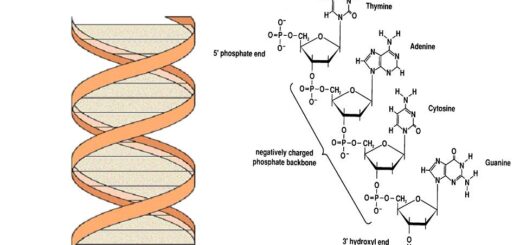Autotrophic Nutrition in green plants, Mechanism of water and minerals absorption
Nutrition is one of the characteristics from which the living organism obtains the energy required for all the vital processes of the body, Nutrition is the scientific study of food and various modes of nutrition of living organisms.
Nutrition
The importance of food for living organisms is that it is a source of the required energy to do all vital processes in the body of the living organism, It constitutes the material needed for the growth and repair of the worn-out tissues.
Types of nutrition
There are two types of nutrition which are Autotrophic nutrition and heterotrophic nutrition.
Autotrophic nutrition
Autotrophic nutrition is a type of nutrition in which autotrophs can manufacture their food by themselves.
Examples: The green plants and some types of bacteria can synthesize, inside their cells, the high-energy types of organic food (such as sugar, starch, fats, and proteins) from the simple, raw, and low-energy inorganic materials (such as CO2, water and mineral salts) from the surrounding habitat.
They use these low-energy materials together with light energy and carry out certain chemical reactions during a process which is called photosynthesis.
Heterotrophic nutrition
Heterotrophic nutrition is a type of nutrition in which heterotrophs obtain their food from the bodies of other living organisms, They obtain high-energy food substances either from green plants or from animals that have previously fed on plants.
Examples: Heterotrophs can be classified into:
- Parasites such as Bilharzia worms and Orobanche.
- Saprophytes such as some fungi and saprophytic bacteria.
- Holozoic nutrition includes Herbivores feed on the plants, Carnivores feed on the animals’ flesh, Omnivores feed on both animals and plants.
Autotrophic nutrition in green plants
Autotrophic nutrition which is carried out by green plants includes two important processes which are the process of absorption of water, salts, and carbon dioxide, the process of photosynthesis.
Process of absorption of water and salts
The higher green plants absorb water and mineral salts from the soil through the root hairs that are present in the root system of the plant, then this soil solution is transported from one cell to another until it finally reaches the ascending vessels.
Root hair is an extension of a single cell of the piliferous layer, It is lined internally with a thin layer of cytoplasm which contains a nucleus and a large sap vacuole, It is about 4 mm.
It doesn’t exist for more than a few days or weeks because the epidermal cells are lost from time to time and regenerated continuously from the zone of elongation, Root hair function is fixing the plant into the soil, absorption of water and mineral salts from the soil.
Adaptation of the root hairs to their functions:
- Being large in number and protruding to the outside, to increase the surface area of absorption.
- Having thin walls, to permit the passage of water and salts through them.
- Secreting a viscous substance to help these hairs find their way easily among the soil particles, to stick to the soil particles so that they can fix the plant into the soil.
- The solution inside their vacuoles is more concentrated than that of the soil to help water pass from the soil to the root hair.
Mechanism of water absorption
The mechanism depends on several physical phenomena such as Diffusion phenomenon and Osmosis phenomenon.
Diffusion phenomenon
Diffusion phenomenon is the movement of molecules of ions from a highly concentrated medium to a low-concentrated medium, due the continuous free motion of molecules of the diffused substance, such as the diffusion of a drop of ink when it falls into a beaker containing water.
Osmosis phenomenon
It is the diffusion (movement) of water from a medium of high concentration of water (low concentration of solute molecules) to another with a low water concentration (high concentration of solute molecules) through a semi-permeable membrane, The pressure that causes the water movement is called osmotic pressure.
Osmosis phenomenon is the pressure that causes the diffusion of water through a semi-permeable membrane, due to the difference in concentration of the dissolving substances (solutes) in water on the two sides of the membrane.
The relation between the concentration of solutes in the solution and the osmotic pressure of the solution is directly proportional, The osmotic pressure increases by increasing the concentration of solutes in the solution.
Permeability phenomenon
The cell walls and cell membranes differ in their permeability properties, as the following :
Walls and membranes are impermeable, They do not allow water and salts to pass, such as the walls covered by lignin, suberin or cutin.
Walls and membranes are permeable, They allow water and salts to pass, such as cellulose walls.
Walls and membranes are semi-permeable (selectively permeable), They allow the passage of water, they control the permeability of many salts, They prevent the permeability of sugars and amino acids because they are large-sized molecules, such as plasma membranes.
Selective permeability: A phenomenon which controls the passage of substances through the plasma membranes in which some substances may be allowed to pass freely through the tiny pores of plasma membranes, while others may pass through them slowly, A third group of substances is not allowed to pass at all.
Plasma membrane: A semi-permeable membrane with tiny pores that can control the passage of substances through them by the selective permeability phenomenon.
Imbibition phenomenon
It is the ability of plant cell’s walls to absorb water through the solid particles, especially the colloidal ones, that have the ability to absorb liquids, swell, and increase in volume, From the colloidal substances: cellulose, pectin, and protoplasm proteins.
Explanation of water absorption by the root
The root hairs are covered by a thin colloidal layer, so, they possess a strong affinity for water which surrounds the adjacent soil particles, so, the outer surface of the root hairs will imbibe water from the soil solution by imbibition.
The imbibed water is then withdrawn to the inside of epidermal cells by osmosis, because the solution in the cell sap is more concentrated than that of the soil solution, due to the difference in water concentration which is higher in the soil than in the cell sap.
Water is absorbed by the same method to the cortex cells until it reaches the xylem vessels in the centre of the root.
Absorption of mineral salts
Scientists have proved that the plant needs certain essential elements (besides carbon, hydrogen, and oxygen ) and it can absorb these elements through the root.
The deficiency of these elements would lead to disturbance in the plant growth which may stop completely and prevent the production of flowers or fruits, These elements are divided into two groups which are Macro-nutrients and Micro-nutrients.
Macro-nutrients
The plant needs these elements in considerable quantities, Number of macro-nutrients is seven: nitrogen, phosphorus, potassium, calcium, magnesium, sulphur, and ion.
Macro-nutrients importance
- Some mineral salts such as nitrates (NO3)−, Phosphate (PO4)− and sulphates (SO4)− are required to convert carbohydrates into proteins.
- Phosphorus enters in the composition of the energy carrier compounds during the photosynthesis process.
- Iron is important for the building up of some enzymes which help to complete the photosynthesis process.
- Magnesium is required for the synthesis of chlorophyll.
Micro-nutrients
The plant needs these elements in very small quantities which do not exceed a few milligrams per liter, They may also be called trace elements.
The number of micro-nutrients is eight: Manganese, zinc, boron, aluminum, chlorine, copper, molybdenum and iodine, Importance of micro-nutrients: these elements help in the activation of some enzymes.
Mechanism of minerals absorption
This mechanism depends on several physical phenomena, which are Diffusion, Selective permeability, and Active transport.
Diffusion
Solutes are present in specific ionic forms that are available to the plant, These ions behave independently of each other and of water itself, They are present as positive ions (Cations) such as and K+ and Ca++, negative ions (Anions) such as (SO4)−−, (NO3)−, (Cl)− and (NO2)−.
These solutes move by diffusion from the soil solution (high-concentrated medium) and pass through the wet cellulose walls (low-concentrated medium), due to the continuous movement of free ions.
Under certain conditions, cations exchange may take place through the cell membrane, such as Na+ ions may get out of the cell and be replaced by K+ ions.
Selective permeability
When the ions reach the semi-permeable plasma membrane, Some ions are selected and allowed to pass through it, according to the plant’s requirement, Some other ions are not permitted in regardless of their sizes or concentrations or charges.
Active transport
Sometimes the ions accumulate inside the cell against the concentration gradient, Ions diffuse from the soil solution, where the low concentration to inside the cell which is higher in concentration, therefore, energy is needed to force these ions to move against the concentration gradient, This phenomenon is known as active transport.
Active transport is the movement of any substance through the cell membrane against the concentration gradient (from low high concentration) with the help of some chemical energy.
Experiment on Nitella alga
The results of an experiment done on Nitella alga which lives in swamps, It is clear that the concentration of various ions that are concentrated in the cell sap of this alga is higher than their concentration in the water of a swamp, Such a case necessitates that the cell must use up some energy to absorb these ions.
The concentration of some ions that are accumulated in one cell is higher than the other, this proves that the ions are selectively absorbed, according to the cell’s requirement.
Asexual and sexual reproduction in plants, Pollination and Stages of fertilization process in plants
Structure of leaf and green plastid, Mechanism of photosynthesis in green plants




